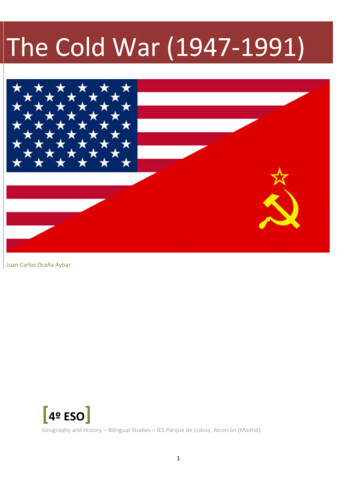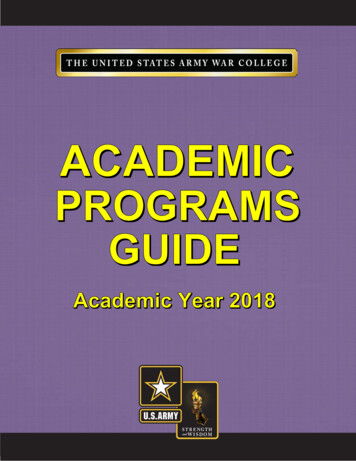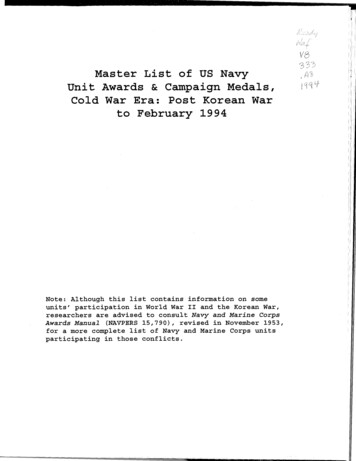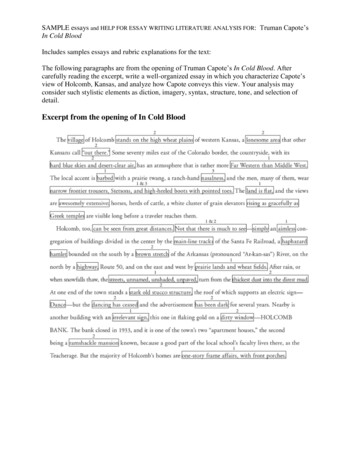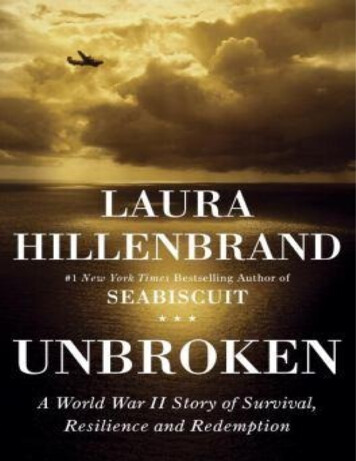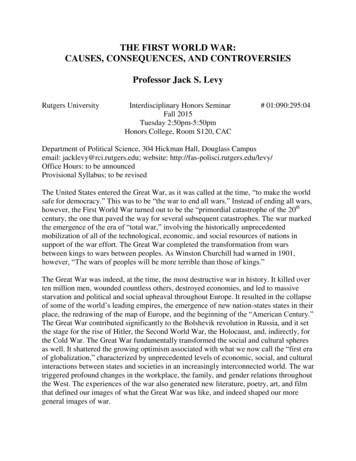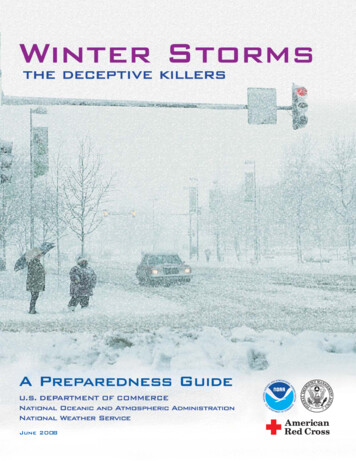
Transcription
The Cold War: A Very Short Introduction‘McMahon has produced a commanding short narrative of a vitalperiod in recent world history. Clear, concise, and compelling, The ColdWar is a superb primer on the subject.’Fredrik Logevall, University of California, Santa Barbara
Very Short Introductions are for anyone wanting a stimulatingand accessible way in to a new subject. They are written by experts, and havebeen published in more than 25 languages worldwide.The series began in 1995, and now represents a wide variety of topicsin history, philosophy, religion, science, and the humanities. Over the nextfew years it will grow to a library of around 200 volumes – a Very ShortIntroduction to everything from ancient Egypt and Indian philosophy toconceptual art and cosmology.Very Short Introductions available now:ANCIENT PHILOSOPHYJulia AnnasTHE ANGLO-SAXON AGEJohn BlairANIMAL RIGHTS David DeGraziaARCHAEOLOGY Paul BahnARCHITECTUREAndrew BallantyneARISTOTLE Jonathan BarnesART HISTORY Dana ArnoldART THEORY Cynthia FreelandTHE HISTORY OFASTRONOMY Michael HoskinAtheism Julian BagginiAugustine Henry ChadwickBARTHES Jonathan CullerTHE BIBLE John RichesBRITISH POLITICSAnthony WrightBuddha Michael CarrithersBUDDHISM Damien KeownCAPITALISM James FulcherTHE CELTS Barry CunliffeCHOICE THEORYMichael AllinghamCHRISTIAN ART Beth WilliamsonCLASSICS Mary Beard andJohn HendersonCLAUSEWITZ Michael HowardTHE COLD WARRobert McMahonContinental PhilosophySimon CritchleyCOSMOLOGY Peter ColesCRYPTOGRAPHYFred Piper and Sean MurphyDADA AND SURREALISMDavid HopkinsDarwin Jonathan HowardDemocracy Bernard CrickDESCARTES Tom SorellDRUGS Leslie IversenTHE EARTH Martin RedfernEGYPTIAN MYTHOLOGYGeraldine PinchEIGHTEENTH-CENTURYBRITAIN Paul LangfordTHE ELEMENTS Philip BallEMOTION Dylan EvansEMPIRE Stephen HoweENGELS Terrell CarverEthics Simon BlackburnThe European UnionJohn PinderEVOLUTIONBrian and Deborah CharlesworthFASCISM Kevin PassmoreTHE FRENCH REVOLUTIONWilliam DoyleFreud Anthony StorrGalileo Stillman DrakeGandhi Bhikhu Parekh
GLOBALIZATIONManfred StegerHEGEL Peter SingerHEIDEGGER Michael InwoodHINDUISM Kim KnottHISTORY John H. ArnoldHOBBES Richard TuckHUME A. J. AyerIDEOLOGY Michael FreedenIndian PhilosophySue HamiltonIntelligence Ian J. DearyISLAM Malise RuthvenJUDAISM Norman SolomonJung Anthony StevensKANT Roger ScrutonKIERKEGAARD Patrick GardinerTHE KORAN Michael CookLINGUISTICS Peter MatthewsLITERARY THEORYJonathan CullerLOCKE John DunnLOGIC Graham PriestMACHIAVELLI Quentin SkinnerMARX Peter SingerMATHEMATICS Timothy GowersMEDIEVAL BRITAINJohn Gillingham andRalph A. GriffithsMODERN IRELANDSenia PašetaMOLECULES Philip BallMUSIC Nicholas CookNIETZSCHE Michael TannerNINETEENTH-CENTURYBRITAIN Christopher Harvie andH. C. G. MatthewNORTHERN IRELANDMarc Mulhollandpaul E. P. SandersPhilosophy Edward CraigPHILOSOPHY OF SCIENCESamir OkashaPLATO Julia AnnasPOLITICS Kenneth MinoguePOLITICAL PHILOSOPHYDavid MillerPOSTCOLONIALISMRobert YoungPOSTMODERNISMChristopher ButlerPOSTSTRUCTURALISMCatherine BelseyPREHISTORY Chris GosdenPRESOCRATIC PHILOSOPHYCatherine OsbornePsychology Gillian Butler andFreda McManusQUANTUM THEORYJohn PolkinghorneROMAN BRITAIN Peter SalwayROUSSEAU Robert WoklerRUSSELL A. C. GraylingRUSSIAN LITERATURECatriona KellyTHE RUSSIAN REVOLUTIONS. A. SmithSCHIZOPHRENIAChris Frith and Eve JohnstoneSCHOPENHAUERChristopher JanawaySHAKESPEARE Germaine GreerSOCIAL AND CULTURALANTHROPOLOGYJohn Monaghan and Peter JustSOCIOLOGY Steve BruceSocrates C. C. W. TaylorSPINOZA Roger ScrutonSTUART BRITAIN John MorrillTERRORISM Charles TownshendTHEOLOGY David F. FordTHE TUDORS John GuyTWENTIETH-CENTURYBRITAIN Kenneth O. MorganWittgenstein A. C. GraylingWORLD MUSIC Philip Bohlman
Available soon:AFRICAN HISTORYJohn Parker and Richard RathboneANCIENT EGYPT Ian ShawTHE BRAIN Michael O’SheaBUDDHIST ETHICSDamien KeownCHAOS Leonard SmithCHRISTIANITY Linda WoodheadCITIZENSHIP Richard BellamyCLASSICAL ARCHITECTURERobert TavernorCLONING Arlene Judith KlotzkoCONTEMPORARY ARTJulian StallabrassTHE CRUSADESChristopher TyermanDerrida Simon GlendinningDESIGN John HeskettDinosaurs David NormanDREAMING J. Allan HobsonECONOMICS Partha DasguptaTHE END OF THE WORLDBill McGuireEXISTENTIALISM Thomas FlynnTHE FIRST WORLD WARMichael HowardFREE WILL Thomas PinkFUNDAMENTALISMMalise RuthvenHabermas Gordon FinlaysonHIEROGLYPHSPenelope WilsonHIROSHIMA B. R. TomlinsonHUMAN EVOLUTIONBernard WoodINTERNATIONAL RELATIONSPaul WilkinsonJAZZ Brian MortonMANDELA Tom LodgeMEDICAL ETHICSTony HopeTHE MIND Martin DaviesMyth Robert SegalNATIONALISM Steven GrosbyPERCEPTION Richard GregoryPHILOSOPHY OF RELIGIONJack Copeland and Diane ProudfootPHOTOGRAPHYSteve EdwardsTHE RAJ Denis JuddTHE RENAISSANCEJerry BrottonRENAISSANCE ARTGeraldine JohnsonSARTRE Christina HowellsTHE SPANISH CIVIL WARHelen GrahamTRAGEDY Adrian PooleTHE TWENTIETH CENTURYMartin ConwayFor more information visit our web sitewww.oup.co.uk/vsi
Robert McMahonTHE COLD WARA Very Short Introduction1
3Great Clarendon Street, Oxford o x 2 6 d pOxford University Press is a department of the University of Oxford.It furthers the University’s objective of excellence in research, scholarship,and education by publishing worldwide inOxford New YorkAuckland Bangkok Buenos Aires Cape Town ChennaiDar es Salaam Delhi Hong Kong Istanbul Karachi KolkataKuala Lumpur Madrid Melbourne Mexico City Mumbai NairobiSão Paulo Shanghai Taipei Tokyo TorontoOxford is a registered trade mark of Oxford University Pressin the UK and in certain other countriesPublished in the United Statesby Oxford University Press Inc., New York Robert McMahon 2003The moral rights of the author have been assertedDatabase right Oxford University Press (maker)First published as a Very Short Introduction 2003All rights reserved. No part of this publication may be reproduced,stored in a retrieval system, or transmitted, in any form or by any means,without the prior permission in writing of Oxford University Press,or as expressly permitted by law, or under terms agreed with the appropriatereprographics rights organizations. Enquiries concerning reproductionoutside the scope of the above should be sent to the Rights Department,Oxford University Press, at the address aboveYou must not circulate this book in any other binding or coverand you must impose this same condition on any acquirerBritish Library Cataloguing in Publication DataData availableLibrary of Congress Cataloging in Publication DataData availableISBN 13: 978–0–19–280178–4ISBN 10: 0–19–280178–35 7 9 10 8 6 4Typeset by RefineCatch Ltd, Bungay, SuffolkPrinted in Great Britain byTJ International Ltd., Padstow, Cornwall
ContentsPrefaceviiiList of illustrationsList of maps12345678xxiiWorld War II and the destruction of the old orderThe origins of the Cold War in Europe, 1945–50116Towards ‘Hot War’ in Asia, 1945–50 35A global Cold War, 1950–8 56From confrontation to detente, 1958–68 78Cold wars at home 105The rise and fall of superpower detente, 1968–79 122The final phase, 1980–90 143Further reading 169Index175
Preface to this editionWriting a compact history of the conflict that dominated and largelydefined international affairs for nearly half a century has proven anassignment at once challenging, exciting, and daunting. Detailedmonographs, many of them excellent and most considerably longer thanthe present volume, exist for virtually every one of the major events,crises, trends, and personalities discussed in this necessarily slim book.Vigorous, oft-times vituperative scholarly debates, moreover, have ragedover almost every aspect of the Cold War’s history. Those debates havebeen enlivened, and deepened, in recent years with the release ofpreviously secret documentary evidence from archives in the UnitedStates, Russia, Eastern Europe, China, and elsewhere – and by the freshperspectives afforded by the passage of time. This book, consequently,does not – nor could it – purport to be the last word on the Cold War orto represent anything approaching a comprehensive history of thatcomplex, multi-faceted conflict.Rather, in keeping with the general objectives of the Very ShortIntroduction series, my goal has been to provide a broad, interpretiveoverview, one accessible to students and general readers alike. This bookoffers a general account of the Cold War, spanning the period from 1945to the final denouement of the Soviet-American confrontation in 1990.It elucidates key events, trends, and themes, drawing in so doing fromsome of the most important recent scholarship on the Cold War. I havesought, above all, to provide readers with an essential foundation for
understanding and assessing one of the seminal events in modern worldhistory.Inevitably, I have had to make difficult choices in terms of what to cover,and what to omit, about a conflict that spanned four and a half decadesand encompassed virtually the entire globe. Limitations of spaceprecluded treatment of some significant episodes and compelled themost abbreviated possible treatment of others. I also decided to payshort shrift to the military dimensions of the Cold War, partly becauseother volumes in this series will be devoted to the Korean and theVietnam wars. What follows, then, is a ‘very short introduction’ to theCold War, as the title promises, written from an internationalperspective and from a post-Cold War angle of vision. Key guidingquestions addressed by the narrative include: How, when, and why didthe Cold War begin?; Why did it last so long?; Why did it move from itsinitial origins in postwar Europe to embrace almost the entire world?;Why did it end so suddenly and unexpectedly?; And what impact did ithave?I am grateful to Robert Zieger, Lawrence Freedman, and Melvyn Leffler,each of whom read the manuscript and offered valuable suggestions forits improvement. I also thank Rebecca O’Connor for encouragement,advice, and support throughout, along with the entire Oxford UniversityPress editorial staff, who made working on this book a pleasure.
List of illustrations1Churchill, Roosevelt, andStalin at the LivadiaPalace, Yalta, February194521US National Archives andRecords Administration2 Churchill, Truman, andStalin during the PotsdamConference, Germany,July 194524US National Archives andRecords Administration3 Mao Zedong, chairmanof the Chinese CommunistParty41 Corbis4 Hungarians protestagainst the Sovietinvasion, November1956 Hulton DeutschCollection/Corbis635 Ho Chi Minh, president ofthe Democratic Republicof Vietnam73 Bettmann/Corbis6 Kennedy and Khrushchevat the Vienna summit,June 196184US National Archives andRecords Administration7 A medium-range ballisticmissile site at SanCristobal, Cuba, October196290 United States Departmentof Defense/John FitzgeraldKennedy Library, Boston8 Khrushchev and Castroembrace at the UnitedNations, September196095 Corbis9 French political leaderCharles de Gaulle98Photos12.com/BertelsmannLexicon Verlag
10Brezhnev and Nixonmeeting duringBrezhnev’s visit to theUSA, June 197312914US National Archives andRecords Administration12West German ChancellorWilly Brandt130Anti-nucleardemonstration in NewYork City, June 1982 158 Dieter Hespe/Corbis Bettmann/CorbisAfghan mujaheddinrebels with capturedSoviet weapons, nearMatun, 1979149 Setboun/Sipa/Rex Features13156 Henry Ray Abrams/Corbis1511Anti-nucleardemonstration inBrussels, October198116The Berlin Wall comesdown, November1989167 Raymond Depardon/MagnumPhotosReagan and Gorbachev inRed Square during theMoscow summit, May1988152US National Archives andRecords AdministrationThe publisher and the author apologize for any errors or omissionsin the above list. If contacted they will be pleased to rectify these atthe earliest opportunity.
List of mapsICentral Europe after World War II 4From Robert Schulzinger, American Diplomacy in the Twentieth Century (OxfordUniversity Press, 1994)IIThe Korean War, 1950–3 54From Robert Schulzinger, American Diplomacy in the Twentieth Century (OxfordUniversity Press, 1994)III The Middle East 1956 68From Ronald E. Powaski, The Cold War: The United States and the Soviet Union,1917–1991 (Oxford University Press, 1998)IVAfrica in 1945 86From Paterson et al., American Foreign Relations, 5th edn., 2000 HoughtonMifflin Company, used with permissionVAfrica in 2000 87From Paterson et al., American Foreign Relations, 5th edn., 2000 HoughtonMifflin Company, used with permission
Chapter 1World War II and thedestruction of the old orderExplanations for the onset of the Cold War must begin with WorldWar II. A conflict that ranks, by any conceivable measure, as themost destructive in human history, World War II broughtunparalleled levels of death, devastation, privation, anddisorder.‘The conflagration of 1939–1945 was so wrenching, so total, soprofound, that a world was overturned,’ notes historian Thomas G.Paterson, ‘not simply a human world of healthy and productivelaborers, farmers, merchants, financiers, and intellectuals, notsimply a secure world of close-knit families and communities, notsimply a military world of Nazi storm troopers and Japanesekamikazes, but all that and more.’ By unhinging as well ‘the worldof stable politics, inherited wisdom, traditions, institutions,alliances, loyalties, commerce and classes’, the war created theconditions that made great power conflict highly likely, if notinevitable.A world overturnedApproximately 60 million people lost their lives as a direct result ofthe war, fully two-thirds of them noncombatants. The war’s losers,the Axis states of Germany, Japan, and Italy, suffered more than3 million civilian deaths; their conquerors, the Allies, suffered farmore: at least 35 million civilian deaths. An astonishing 10 to 20%1
The Cold Warof the total populations of the Soviet Union, Poland, andYugoslavia perished, between 4 and 6% of the total populations ofGermany, Italy, Austria, Hungary, Japan, and China. If the exacttoll of this wrenching global conflagration continues to defy allefforts at statistical precision, the magnitude of the human lossesit claimed surely remains as shockingly unfathomable twogenerations after World War II as it was in the conflict’simmediate aftermath.At war’s end, much of the European continent lay in ruins. BritishPrime Minister Winston S. Churchill, in characteristically vividprose, described postwar Europe as ‘a rubble heap, a charnel house,a breeding ground of pestilence and hate’. Berlin was ‘an utterwasteland’, observed correspondent William Shirer, ‘I don’t thinkthere has ever been such destruction on such a scale’. In fact, manyof the largest cities of central and eastern Europe sufferedcomparable levels of devastation; 90% of the buildings in Cologne,Düsseldorf, and Hamburg were gutted by Allied bombing, 70% ofthose in the centre of Vienna. In Warsaw, reported John Hershey,the Germans had ‘destroyed, systematically, street by street, alley byalley, house by house. Nothing is left except a mockery ofarchitecture’. US Ambassador Arthur Bliss Lane, upon enteringthat war-ravaged city in July 1945, wrote: ‘The sickening sweetodor of burned human flesh was a grim warning that we wereentering a city of the dead.’ In France, fully one-fifth of the nation’sbuildings were damaged or destroyed; in Greece, one-quarter. Evennever-occupied Great Britain suffered extensive damage,principally from Nazi bombing, while losing an estimated onequarter of its total national wealth in the course of the conflict.Soviet losses were the most severe of all: at least 25 million dead,another 25 million rendered homeless, 6 million buildingsdestroyed, and much of the country’s industrial plant andproductive farmland laid to waste. Across Europe, an estimated 50million of the war’s survivors had been uprooted by the war, some16 million of them euphemistically termed ‘displaced persons’ bythe victorious Allies.2
The vast swath of death and destruction precipitated by the war leftnot only much of Europe and Asia in ruins but the old internationalorder as well. ‘The whole world structure and order that we hadinherited from the nineteenth century was gone’, marvelled USAssistant Secretary of State Dean Acheson. Indeed, the Eurocentricinternational system that had dominated world affairs for the past500 years had, virtually overnight, vanished. Two continent-sizedmilitary behemoths – already being dubbed superpowers – hadrisen in its stead, each intent upon forging a new order consonantwith its particular needs and values. As the war moved into its finalphase, even the most casual observer of world politics could see thatthe United States and the Soviet Union held most of the military,economic, and diplomatic cards. On one basic goal, those3World War II and the destruction of the old orderConditions in postwar Asia were nearly as grim. Almost all ofJapan’s cities had been ravaged by relentless US bombing, with40% of its urban areas completely destroyed. Tokyo, Japan’slargest metropolis, was gutted by Allied firebombing thatlevelled more than half of its buildings. Hiroshima andNagasaki met an even more dire fate as the twin atomicblasts that brought the Pacific War to a close left them obliterated.Approximately 9 million Japanese were homeless when theirleaders finally surrendered. In China, a battleground for morethan a decade, the industrial plant of Manchuria lay in shambles,the rich farmland of the Yellow River engulfed in floods. Asmany as 4 million Indonesians perished as a direct orindirect result of the conflict. One million Indians succumbedto war-induced famine in 1943, another million people inIndo-China two years later. Although much of SoutheastAsia was spared the direct horrors of war visited upon Japan,China, and various Pacific islands, other parts, such as thePhilippines and Burma, were not so fortunate. During thewar’s final stage, 80% of Manila’s buildings were razed in savagefighting. Equally brutal combat in Burma, in the testimony ofwartime leader Ba Maw, ‘had reduced an enormous part of thecountry to ruins’.
Map I. Central Europe after World War II.
adversaries-turned-allies were in essential accord: that somesemblance of authority and stability needed to be restored withdispatch – and not just to those areas directly affected by the warbut to the broader international system as well. The task was asurgent as it was daunting since, as Under Secretary of State JosephGrew warned in June 1945: ‘Anarchy may result from the presenteconomic distress and political unrest.’5World War II and the destruction of the old orderThe immediate roots of the Cold War, at least in broad, structuralterms, lay in the intersection between a world rendered prostrateby a devastating global conflict and the conflicting recipes forinternational order that Washington and Moscow sought toimpose on that pliable, war-shattered world. Some degree ofconflict invariably results whenever a prevailing internationalorder and its accompanying balance of power system areoverturned. One would certainly expect no less when theoverturning occurs with such shattering suddenness. The tension,suspicion, and rivalry that came to plague US–Soviet relations inthe immediate aftermath of war was, in that elemental sense,hardly a surprise. Yet the degree and scope of the ensuing conflict,and particularly its duration, cannot be explained by appeals tostructural forces alone. History, after all, offers numerous examplesof great powers following the path of compromise and cooperation,opting to act in concert so as to establish a mutually acceptableinternational order capable of satisfying the most fundamentalinterests of each. Scholars have employed the term ‘great powercondominium’ to describe such systems. Despite the hopes of someleading officials in both the United States and the Soviet Union,however, that would not be the case this time. The reasons why goto the heart of the question of Cold War origins. In brief, it was thedivergent aspirations, needs, histories, governing institutions, andideologies of the United States and the Soviet Union that turnedunavoidable tensions into the epic four-decade confrontation thatwe call the Cold War.
The Cold WarAmerican visions of postwar orderThe United States emerged from the wreckage of World War II withrelatively moderate losses. Although some 400,000 of the nation’ssoldiers and sailors gave their lives in the struggle against the Axispowers, approximately three-quarters of them on the battlefield, itbears emphasizing that those numbers represent less than 1% ofthe war’s overall death toll and less than 2% of the losses sufferedby America’s Soviet partner. For most US civilians, in stunningcontrast to their counterparts across Europe, East Asia, NorthAfrica, and elsewhere, the war meant not suffering and privationbut prosperity – even abundance. The nation’s gross domesticproduct doubled between 1941 and 1945, bestowing the wondersof a highly productive, full-employment economy on a citizenrythat had become accustomed to the deprivations imposed by adecade-long depression. Real wages rose rapidly and dramaticallyduring the war years, and homefront Americans found themselvesawash in a cornucopia of now-affordable consumer goods. ‘TheAmerican people’, remarked the director of the Office of WarMobilization and Reconversion, ‘are in the pleasant predicamentof having to learn to live 50 percent better than they have everlived before.’In March 1945, newly installed President Harry S. Truman wasmerely stating the self-evident when he commented: ‘We haveemerged from this war the most powerful nation in the world – themost powerful nation, perhaps, in all history.’ Yet neither theeconomic benefits conferred on the American people by the war northe soaring military power, productive strength, and internationalprestige attained by their nation during the struggle against Axisaggression could lessen the frightening uncertainties of the newworld ushered in by the war. The Japanese attack at Pearl Harbordecisively shattered the illusion of invulnerability that Americanshad enjoyed ever since the end of the Napoleonic Wars of the early19th century. The obsession with national security thatbecame so central a motif of US foreign and defence policy6
throughout the Cold War era can be traced back directly to themyth-puncturing events that culminated with the Japanesestrike of 7 December 1941. Not until the terrorist attacks onNew York and Washington 60 years later would Americans againexperience so direct, and so wholly unanticipated, an assault ontheir homeland.Second, and even more broadly, senior American strategistsdetermined that the nation’s military power must never again beallowed to atrophy. US military strength, they were agreed, mustform a core element of the new world order. The Franklin D.Roosevelt and Harry S. Truman administrations were, accordingly,insistent upon maintaining naval and air forces second to none; astrong military presence in the Pacific; dominance of the Westernhemisphere; a central role in the occupations of defeated7World War II and the destruction of the old orderMilitary strategists took several lessons from the bold Japanesestrike, each of which carried profound implications for the future.They became convinced, first, that technology, and especially airpower, had so contracted the globe that America’s vaunted twoocean barrier no longer afforded sufficient protection from externalassault. True security now required a defence that began wellbeyond the home shores – a defence in depth, in military parlance.That concept led defence officials of the Roosevelt and Trumanadministrations to advocate the establishment of an integrated,global network of US-controlled air and naval bases, as well as thenegotiation of widespread military air transit rights. Together,those would allow the United States to project its power moreeasily into potential trouble spots and to stifle or deter prospectiveenemies long before they gained the power to strike at Americanterritory. A sense of how extensive US military base requirementswere can be gleaned from a 1946 list of ‘essential’ sites compiled bythe State Department; it included, among other locales, Burma,Canada, the Fiji Islands, New Zealand, Cuba, Greenland, Ecuador,French Morocco, Senegal, Iceland, Liberia, Panama, Peru, and theAzores.
The Cold Waradversaries Italy, Germany, Austria, and Japan; and a continuedmonopoly on the atomic bomb. Even before the eruption of the ColdWar, US strategic planners were operating from an extraordinarilyexpansive concept of national security.That broad vision of the nation’s security requirements wasreinforced by a third, overarching lesson that US policy-makersdrew from the World War II experience: namely, that never againcould a hostile state, or coalition of states, be allowed to gainpreponderant control over the populations, territories, andresources of Europe and East Asia. The Eurasian heartland, asgeopoliticians were fond of labelling it, ranked as the world’sgreatest strategic-economic prize; its combination of rich naturalresources, advanced industrial infrastructure, skilled labour, andsophisticated military facilities made it the fulcrum of worldpower, as the events of 1940–1 made painfully clear. When theAxis powers seized control over much of Eurasia in the early1940s, they gained the wherewithal to wage protracted war,subvert the world economy, commit heinous crimes againsthumanity, and threaten and ultimately attack the Westernhemisphere. If such an eventuality came to pass again, US defenceofficials worried, the international system would once again bebadly destabilized, the balance of world power dangerouslydistorted, and the physical safety of the United States put at graverisk. Moreover, even if a direct attack on the United States couldbe averted, American leaders would still be forced to prepare forone – and that would mean a radical increase in both militaryspending and the size of its permanent defence establishment, areconfiguration of the domestic economy, and the curtailment ofcherished economic and political freedoms at home. Axisdominance of Eurasia, in short, or control over Eurasia by anyfuture enemy, would thus also jeopardize the political economyof freedom so crucial to core US beliefs and values. The WorldWar II experience thus offered hard lessons about the criticalimportance of maintaining a favourable balance of power inEurasia.8
In a December 1944 editorial, the Chicago Tribune captured thebuoyancy and self-confidence of American society when it proudlyproclaimed that it was ‘the good fortune of the world’, and not justthe United States, that ‘power and unquestionable intentions’ now‘went together’ in the Great American Republic. Such convictions9World War II and the destruction of the old orderThe military-strategic dimensions of world order were, in Americanthinking, inseparable from the economic dimensions. US plannersviewed the establishment of a freer and more open internationaleconomic system as equally indispensable to the new order theywere determined to construct from the ashes of history’s mosthorrific conflict. Experience had instructed them, Secretary of StateCordell Hull recalled, that free trade stood as an essentialprerequisite for peace. The autarky, closed trading blocs, andnationalistic barriers to foreign investment and currencyconvertibility that had characterized the depression decade justencouraged interstate rivalry and conflict. A more open world,according to the American formula, would be a more prosperousworld; and a more prosperous world would, in turn, be a morestable and peaceful world. To achieve those ends, the United Statespushed hard in wartime diplomatic councils for a multilateraleconomic regime of liberalized trade, equal investmentopportunities for all nations, stable exchange rates, and fullcurrency convertibility. At the Bretton Woods Conference late in1944, the United States gained general acceptance of thoseprinciples, along with support for the establishment of two keysupranational bodies, the International Monetary Fund and theInternational Bank for Reconstruction and Development (WorldBank), charged with helping to stabilize the global economy. Thatthe United States, the world’s leading capitalist state and one thatwas producing an astonishing 50% of the world’s goods and servicesat war’s end, would surely benefit from the new, multilateralcommercial regime so vigorously endorsed by the Roosevelt andTruman administrations and the US business community was agiven. American ideals here were inextricably interwoven withAmerican interests.
The Cold Warabout the righteous destiny of the United States tapped deep rootswithin American history and culture. Elites and non-elites alikeaccepted the notion that it was their country’s historic responsibilityto bring about a new, more peaceful, prosperous, and stable world.US leaders betrayed few doubts about the ability of their nation toeffect so momentous a transition; nor did they acknowledge anypotential conflict between the global order they sought to forge andthe needs and interests of the rest of humanity. With the hubris of apeople who had known few failures, Americans thought that theycould, in Dean Acheson’s choice words, ‘grab hold of history andmake it conform’. Only one significant obstacle loomed. The SovietUnion, cautioned Life magazine in July 1945, ‘is the number oneproblem for Americans because it is the only country in the worldwith the dynamic power to challenge our own conceptions of truth,justice, and the good life’.Soviet visions of postwar orderThe Soviet blueprint for postwar order was also born of deep-rootedsecurity fears. As in the American case, those fears were refractedthrough the filters of history, culture, and ideology. Soviet memoriesof Hitler’s surprise attack of June 1941 were just as vivid – and farmore terrifying – than were American memories of Pearl Harbor. Itcould hardly have been otherwise in a land that had endured suchs
Contents Preface viii List of illustrations x List of maps xii 1 World War II and the destruction of the old order 1 2 The origins of the Cold War in Europe, 1945–50 16 3 Towards ‘Hot War’ in Asia, 1945–50 35 4 A global Cold War, 1950–8 56 5 From confrontation to detente, 1958–68 78 6 Cold wars at home 1


